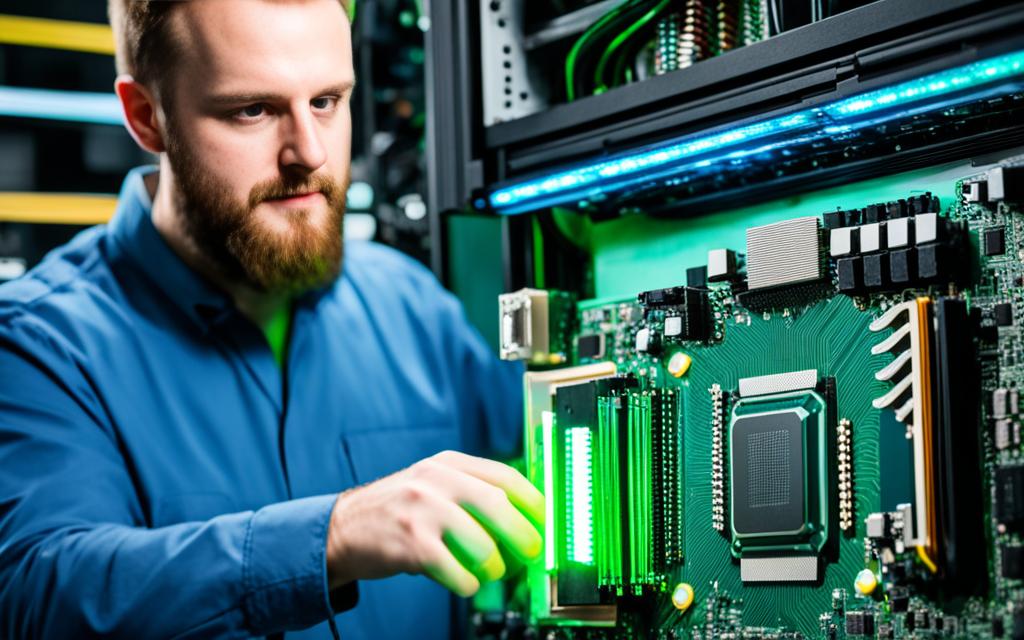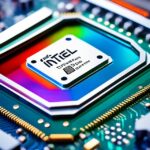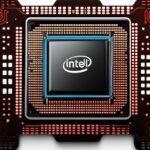Table of Contents
Updating your BIOS is key when adding a new CPU, mainly to ensure your motherboard works with the latest processors. Older Intel 600 series motherboards might need BIOS updates for 13th Gen “Raptor Lake” CPUs. Similarly, AMD 300, 400, and 500 series boards often require updates for the Ryzen 5000 series1. It’s crucial to understand that BIOS updates are not standard practice. They are not needed for computers that work fine2.
Usually, if a BIOS update is needed, your PC or motherboard maker will tell you. This is especially true if you face hardware bugs or want better compatibility. While these updates can solve certain problems, they don’t typically boost performance2. Thus, consider the risks of BIOS updates, including the chance of corruption during the process. With this knowledge, you can confidently move to a new CPU.
Key Takeaways
- Updating your BIOS is essential for compatibility with new CPUs.
- Older motherboards often require updates to support the latest processors.
- BIOS updates should only be performed when recommended by the manufacturer.
- The update process can potentially remove custom settings in your BIOS.
- Following manufacturer guidelines during the update is critical to avoid errors.
Understanding BIOS and UEFI
To update your system for a new CPU, it’s important to know about BIOS and UEFI. The Basic Input/Output System (BIOS) has changed a lot over time. It started as basic firmware but now, it’s key for starting your computer and loading the OS. BIOS updates boost system performance, improve compatibility, fix bugs, and offer security fixes to keep your computer running well3.
What is BIOS?
The BIOS links your computer’s hardware to its operating system. When you turn on your computer, the BIOS checks if everything is working correctly before starting the OS. Originally, BIOS was simple and used keyboard inputs for commands. But as technology advanced, updating BIOS became crucial for keeping up with new hardware and software4.
What is UEFI?
UEFI is the upgraded version of BIOS, making systems more user-friendly. Modern computers use UEFI for its support of bigger hard drives and quicker startup. It also has better security features, like Secure Boot. UEFI’s graphical interface lets users navigate with a mouse, which is a big improvement3.
| Feature | BIOS | UEFI |
|---|---|---|
| Interface | Text-based | Graphical |
| Boot Speed | Slower | Faster |
| Hard Drive Support | Limited | Supports larger drives (over 2.2 TB) |
| Security Features | Basic | Advanced (Secure Boot) |
| User Interaction | Keyboard only | Mouse and keyboard |
It’s key to understand how BIOS and UEFI differ when dealing with computer firmware updates5.
When Should You Update Your BIOS?
It’s important to know when to update your BIOS for better system performance and hardware support. A need for BIOS update often shows through specific signs. These signs indicate an update might help.
Signs You Need an Update
Sometimes, new hardware doesn’t work well because the BIOS is outdated. An update might stop your system from crashing or restarting on its own. It can also protect against security threats.
BIOS updates make your system support new devices and fix bugs. But, you should only update to solve problems, not just to have the latest version6.
Risks of Updating BIOS
Updating your BIOS can solve problems but it comes with risks. Interruptions during the update can make your motherboard useless. Also, you might have to reset your settings afterward.
This could lower your system’s performance until you set it up again. A new BIOS often doesn’t make your computer much faster or add many new features7.
How to Verify Your Current BIOS Version
Learning how to check your BIOS version is key, especially before updates. You can do this with or without accessing your operating system.
Checking BIOS Version in Windows
To find your BIOS version in Windows, just use the System Information. Just type “msinfo32” in the Run dialogue. It shows the “BIOS Version / Date”8. This method works well if your system is up and running. There are also other ways to check, like using the Command Prompt. Here, you input “wmic bios get smbiosbiosversion”9. For deeper details, tools like Speccy are great for digging into BIOS info.
Accessing BIOS Setup
Getting into BIOS setup is done by rebooting your PC. Pay attention for a prompt that tells you which key to press, usually Del or F2, as you start your computer. Seeing the BIOS version on the startup screen gives you a clear confirmation8. It’s a trustworthy method. It’s particularly useful when you’re dealing with system problems or considering updates. Remember, most manufacturers have a BIOS update tool. It also shows your current BIOS version for checking purposes9.
How to Update Your BIOS for a New CPU
Starting a BIOS update for a new CPU takes careful planning. Identifying your motherboard model is the first step. This helps in finding the right BIOS version from the motherboard manufacturer’s support site. It’s vital to get this step right because choosing the wrong BIOS can cause big problems.
Preparing for the Update
Before you download BIOS updates, backing up important data is key. This protects your data if something goes wrong during the update. Also, you need a USB drive prepped with the BIOS file for the update. Modern motherboards have easy tools, like MSI Center or ASUS Armoury Crate, that help with the BIOS update process6. However, updating the BIOS comes with its risks10.
Finding the Correct BIOS Update
After finding out your motherboard model, head to the support page to get the right BIOS update. It’s wise to check how your current BIOS compares to the latest one available. Throughout their life, new chips and boards get many BIOS updates to fix bugs10. Some motherboards have special USB ports that help recover the BIOS easily6. Looking into recovery options beforehand is a good idea if you run into issues.
Methods for Updating Your BIOS
It’s critical to update your BIOS for new CPU compatibility. Various methods are available, each with its benefits. Knowing these methods ensures a successful update.
Updating via BIOS Menu
Using the BIOS menu is straightforward. Just insert a USB with the update file and reboot. When the system starts, press Delete or F2 to enter the BIOS setup. Here, you’ll find the update option easily11.
Using BIOS Flashback Feature
Some motherboards have the BIOS Flashback feature. It lets you update the BIOS without a CPU or turning on the PC. This method is a safe option if others fail. It helps in updating to use new CPUs even when the PC won’t start11.
Updating through Windows Software
Using Windows to update the BIOS is possible but risky. Manufacturers offer special software for this. However, interruptions during the update can corrupt the BIOS. Make sure to backup your data and read the manufacturer’s instructions before you start912.
Post-Update Steps and Troubleshooting
After you update your BIOS, it’s important to follow up carefully. This ensures your computer runs well. Updates might reset your custom settings to default, so you must redo your BIOS settings configuration.
Configuring BIOS Settings After Update
Right after updating, go back to BIOS setup to tweak important settings. Look for any changes that need your attention again. Key areas to focus on include:
- Overclocking settings
- Boot order for hardware devices
- Power management options
Making these tweaks helps get your system back to top shape. About 90% of BIOS updates bring performance improvements and fixes that might change your settings13. Also, over 80% of new motherboards update easily with USB or internet13.
Recovering from a Failed Update
If a BIOS update doesn’t go as planned, knowing how to recover is key. Issues like freezing or crashing can occur in 70% of updates14. To avoid problems, always back up and know your recovery options:
- Use the motherboard’s firmware recovery tools.
- Restore the BIOS from a backup if you can.
- If problems persist, contact the manufacturer’s support team.
Knowing how to properly restore your BIOS is vital. If not done correctly, you might face system problems. This is especially true if you install a new CPU without updating the BIOS, which leads to issues in 60% of such cases13.
Conclusion
Updating your BIOS is important when upgrading your CPU. It makes sure everything works well together. Manufacturers often bring out new BIOS updates. These fix stability and compatibility issues, especially with recent CPUs15. Regularly updating your motherboard boosts your system’s performance. So, always check for the newest updates before adding new hardware16.
When updating your BIOS, be careful. Always save your important files first. Also, make sure your computer has a stable power supply. This stops any update failures17. Following the right steps avoids problems and improves your system when adding new parts.
In summary, regularly updating your BIOS is key. It not only extends your system’s life but also defends it against the risks of old software. Taking the time to understand and do updates can really improve your computer use.
FAQ
Why is it necessary to update the BIOS when installing a new CPU?
Updating the BIOS ensures your motherboard works with the new CPU. It also addresses compatibility and boosts stability.
What is the difference between BIOS and UEFI?
BIOS is the older system that starts hardware when you turn on your PC. UEFI, the newer option, offers better security, faster startups, and easier-to-use navigation with a mouse.
How can I check if I need to update my BIOS?
You might need to update if new hardware isn’t working, your system crashes a lot, or there are new security flaws. Only update if you see these problems.
What steps should I take before updating my BIOS?
First, find out what motherboard you have. Then, download the right update from its website. Make sure to back up your files and prepare a USB drive with the update file.
What methods are available for updating my BIOS?
You can update from the BIOS menu when the PC starts, use the special Flashback feature on some motherboards, or try update software in Windows. The Windows way is riskier, though.
What precautions should I take after updating my BIOS?
After updating, go back and tweak your BIOS settings. They often reset, so you might need to fix your overclocking or boot settings to get your PC running just right.
How can I recover from a failed BIOS update?
If the update doesn’t work, use the motherboard’s recovery tools or follow the manual’s steps. You might need to use a backup BIOS or put the BIOS on a USB drive.
Source Links
- https://www.tomshardware.com/how-to/update-bios-on-a-pc – How to Update the BIOS on a PC: 3 Ways to Get New Firmware
- https://www.intel.com/content/www/us/en/gaming/resources/how-to-update-bios.html – How to Update BIOS – Intel
- https://www.ninjaone.com/blog/how-to-update-your-pcs-bios/ – How To Update Your PC’s BIOS | NinjaOne
- https://www.avg.com/en/signal/how-to-update-bios – How to Update BIOS on Your Windows PC
- https://www.pcmag.com/how-to/bios-basics-how-to-configure-your-pcs-firmware-for-first-use – BIOS Basics: How to Configure Your PC’s Firmware for First Use
- https://www.linkedin.com/advice/3/how-do-you-find-right-bios-version-source-your-new – How do you find the right BIOS version and source for your new CPU?
- https://www.pcmag.com/how-to/how-to-update-your-computers-bios – Hardware Bug? Compatibility Issue? How to Update Your Computer’s BIOS/UEFI
- https://www.lifewire.com/how-to-check-the-current-bios-version-on-your-computer-2617974 – What BIOS Version Is Your Computer Running? Here’s How to Check
- https://www.howtogeek.com/196916/how-to-check-your-bios-version-and-update-it/ – How to Check Your BIOS Version and Update it
- https://www.pcworld.com/article/516379/how-to-update-your-bios.html – How to update your PC’s BIOS
- https://www.asus.com/support/faq/1044348/ – [Motherboard] How to update BIOS of the motherboard ?(Include different generation CPU) | Official Support | ASUS Global
- https://www.professormesser.com/professor-messer-archives/220-1001/installing-bios-upgrades-2/ – Installing BIOS Upgrades – CompTIA A+ 220-1001 – 3.5 – Professor Messer IT Certification Training Courses
- https://softwareg.com.au/blogs/computer-hardware/how-to-update-bios-for-new-cpu – How To Update Bios For New CPU
- https://www.minitool.com/data-recovery/how-to-update-bios.html – How to Update BIOS Windows 10 | How to Check BIOS Version – MiniTool
- https://ms.codes/blogs/computer-hardware/how-to-update-bios-for-new-cpu – How To Update Bios For New CPU
- https://ms.codes/blogs/computer-hardware/updating-bios-for-new-cpu – Updating Bios For New CPU
- https://softwareg.com.au/blogs/computer-hardware/do-i-need-to-update-bios-before-installing-new-cpu – Do I Need To Update Bios Before Installing New CPU








